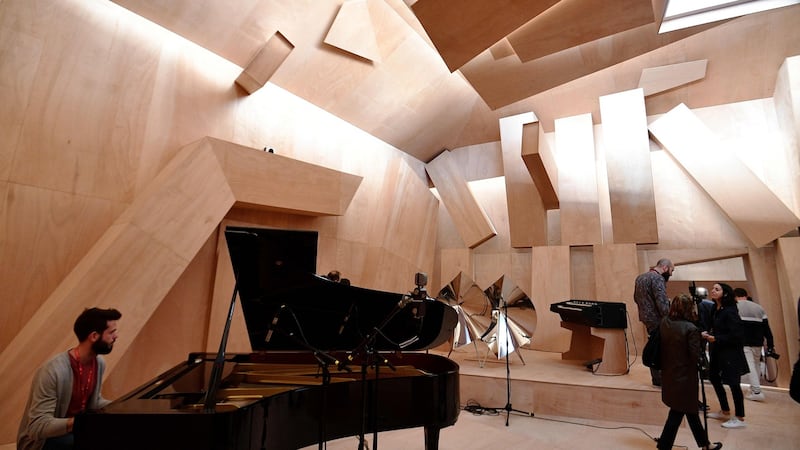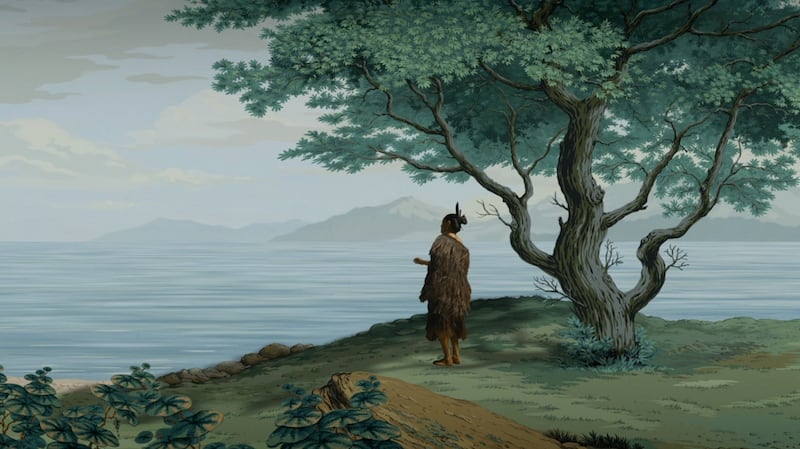I spend my life trying to eliminate the fear of missing out (Fomo) but at the Venice Biennale it’s impossible to avoid. No matter how much you see or do you know you’re missing something else worth seeing or doing. Even five Biennale’s later I haven’t cracked the best way to do it. So, in an attempt to slow down and be present, I picked six exhibitions to take some time with at the 57th Venice Biennale.
The French Pavilion, Xavier Veilhan, Studio Venezia
This show was curated by the historian and critic Lionel Bovier and one of my favourite visual artists and composers Christian Marclay. French representative Xavier Veilhan has created a studio-sculpture that will see more than 100 musicians record in it between now and November.


Numerous instruments have been integrated into this beautifully constructed space, which allows musicians from different horizons and genres to work on site, either individually or collaboratively. The project’s creator, who will be present during the seven months of the Biennale, hopes the pavilion will become a living, breathing space rather than a passive receptacle for predetermined programmes.
Visitors are invited to listen, watch and bear witness to the musical creations in progress. There is no better way to pass the time than to exist in a space with an artist at work and experience the process as a piece itself.
Pavilion of Iceland, Egill Sæbjörnsson, ‘Out of Controll’
Out of Controll is an installation by Ugh and Bõögâr: two trolls turned artists. These lads took control of the Icelandic Pavilion from artist Egill Sæbjörnsson earlier this year. It’s got a café, handcrafted coffee cups, an LP, book, clothing line, perfume, digital experience and more.
The opening is fully immersive, brilliant madness: musician and performance artist Peaches opens a fashion show by pulling some lad’s hand off and eating it; patrons can go fishing for their soul with sandcastle buckets on the ends of fishing rods; and there are about a million Campari spritz. It’s my kind of art: who wouldn’t want to chill and sip coffee observing trolls trolling through Tinder?
The Antarctic Pavilion
Right across the water, the Antarctic Pavilion features a documentation of works created and installed in the world’s southernmost continent during the first ever Antarctic Biennale, which took place in March, along with additional works by 15 international artists. Included are Irish artist Méadhbh O’Connor and Drop Everything 2016 participant Banrei (Jake Harper).
Méadhbh O’Connor’s piece is a two-part project that includes a film and video documentation of a purpose-built scientific device. Her process involves creating models of the Earth’s atmosphere in a small tank of water and photographing the results. The images bear a striking resemblance to atmospheric phenomena seen at a macro scale on Earth.
This is part of an ongoing project looking at planetary atmospheric circulation, which she is doing as part of her residency at UCD’s Parity Studios. The first film in the project, Climate Simulator, is offered as an “open source artwork”, that shares with the audience the techniques used to create the imagery in the film – you can view it here: https://vimeo.com/216918740.
Banrei’s unignorable Mass Notification uses a multi-channel audio piece to manipulate the sound of sirens. These sirens are projected from military speakers ordinarily used to disperse protests as a form of sonic warfare, but in this case the reconstructed sounds are designed to alter your physiological response and instead create a portal to a type of utopia.
I wanted to take home Winston Chmielinski’s Melting As A Model, That’s All, a meticulously embroidered, deconstructed quilt of flags from the 12 original signatories to the Antarctic Treaty.
Scottish Pavilion, Rachel Maclean, Spite Your Face
I missed this at the pavilion and was suffering the post-fomo stress so much I wrote to the artist on my way home. She got back to me in minutes and gave me access to watch the video piece Spite Your Face.
Everything about this work is exceptional with each of the characters performed by the artist. The piece centres on a Pinocchio-esque figure who rises from a deprived social status to the heights of power by constantly lying. This is a darkly comic moral tale for a generation that has increasingly fewer role models to set the ethical standard. The film presents a post-truth dystopia where the world is turned on its head, leaving the characters untethered to a sense of right and wrong. Terrifying and all too close to the bone. You can see a film on it here: https://www.youtube.com/watch?v=9k7PAcKEMLg.
Future Generation Art Prize at Venice 2017
The Future Generation Art Prize is an international award for artists up to 35 years of age, and its group show features 21 young artists. The stand-outs for me include an exceptionally stunning nine-minute video piece titled Winter Which Was Not There by Georgian artist Vajiko Chachkhiani and Nigerian/American artist Njideka Akunyili Crosby’s large scale drawing/collage piece Cassava Garden.
New Zealand Pavilion, Lisa Reihana, Emissaries
Several years in the making, In Pursuit of Venus [infected] is a cinematic re-imagining by Lisa Reihana of the French scenic wallpaper Les Sauvages De La Mer Pacifique, 1804-1805, also known as Captain Cook’s voyages. This was an 1806 collaboration between wallpaper manufacturer Joseph Dufour et Cie and designer Jean-Gabriel Charvet.
Almost 250 years after the original voyages that inspired them, Reihana employs 21st-century digital technologies to recast and reconsider the wallpaper from a Pacific perspective. The results are outstanding and mesmerising from start to finish.
And the ones I missed . . .
Regardless of all I did see, speedboats I hitched a lift on, and parties I managed to wangle into, here are six pavilions and shows I have major fomo for: The Aalto Natives by Nathaniel Mellors and Erkka Nissinen for Finland. The Gold Lion winner Anne Imhof’s performances pieces as part of her work Faust representing Germany (I did get to walk through the vertigo-inducing pavilion but the queues were years long for each performance).
Rachel Maclean for Scotland; I had serious rage I missed this in situ, but again the queues were massive.
The Pierre Huyghe exhibition. It was “private” the day I tried to go. Nightmare.
Berlin-based Irish artist Mariechen Danz’s installation at the Arsenale. Danz is one of three Irish women showing at the Biennale, and the only Irish artist of the 120 invited artists for the 57th International Art Exhibition Viva Arte Viva, which is curated by Christine Macel.
The Boat is Leaking. The Captain Lied at Fondazione Prada. A transmedia exhibition project, the result of an ongoing, in-depth exchange between writer and film-maker Alexander Kluge, artist Thomas Demand, stage and costume designer Anna Viebrock and curator Udo Kittelmann.











